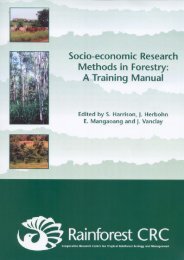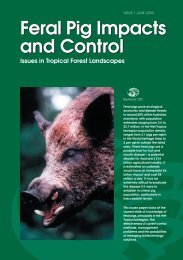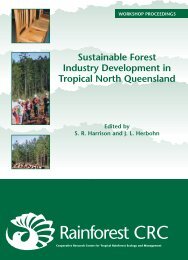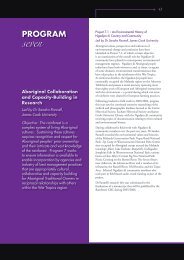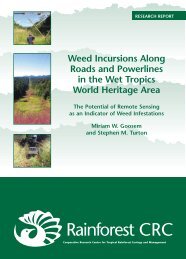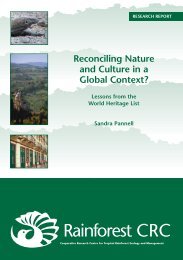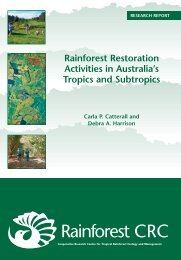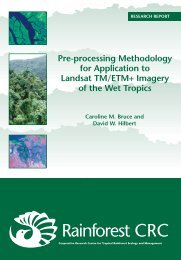S<strong>and</strong>ra Pannell‘habitats of threatened species’ <strong>and</strong> ‘natural sites or natural areas’, which are of “outst<strong>and</strong><strong>in</strong>guniversal value” from the po<strong>in</strong>t of view of science, conservation <strong>and</strong>/or aesthetics (loc. cit.) 3 .The 812 properties currently <strong>in</strong>scribed on the World Heritage List are identified as either‘natural’, ‘cultural’, or as ‘mixed’ heritage (the latter be<strong>in</strong>g a comb<strong>in</strong>ation of cultural <strong>and</strong>natural heritage, as def<strong>in</strong>ed by the Convention). This identification is not only based uponthe Convention’s broad def<strong>in</strong>itions of heritage, but it is also justified accord<strong>in</strong>g to the selectioncriteria presented <strong>in</strong> the Convention’s ‘Operational Guidel<strong>in</strong>es’ for the assessment of‘outst<strong>and</strong><strong>in</strong>g universal value’ 4 . Up until the end of 2004, when the guidel<strong>in</strong>es were aga<strong>in</strong>revised, six of the ten criteria were explicitly identified as ‘cultural’, while the rema<strong>in</strong><strong>in</strong>g fourcriteria were classified as ‘natural’. While the new guidel<strong>in</strong>es (UNESCO 2005a) havesupposedly abolished this dist<strong>in</strong>ction <strong>and</strong> ‘merged’ the ten criteria, properties nom<strong>in</strong>ated <strong>and</strong><strong>in</strong>scribed <strong>in</strong> 2005 are still listed accord<strong>in</strong>g to the tri-partite, pre-2005 classifications.The merg<strong>in</strong>g of ‘nature <strong>and</strong> culture’ to create a “unified set of criteria” (UNESCO 1998: 3)represents the latest of UNESCO’s efforts to redef<strong>in</strong>e the relationship between these two keycategories, <strong>and</strong> further identify the mediatory role played by heritage <strong>in</strong> the global expressionof this dualism. For example, <strong>in</strong> earlier operational guidel<strong>in</strong>es only the criteria for naturalheritage made reference to “man’s <strong>in</strong>teraction with his natural environment” or “exceptionalcomb<strong>in</strong>ations of natural <strong>and</strong> cultural elements”, while the category of ‘mixed’ cultural <strong>and</strong>natural properties did not appear to recognise <strong>in</strong>teractions between its constituent cultural<strong>and</strong> natural elements (Titchen 1995: 240). The 1992 <strong>in</strong>troduction of a fourth World Heritagecategory, that of ‘cultural l<strong>and</strong>scapes’ as the “comb<strong>in</strong>ed works of nature <strong>and</strong> of man”(UNESCO 2005a: 83), reflects a trend towards a more holistic view of the environment, onethat moves away from previous ideas of heritage as necessarily consist<strong>in</strong>g of isolated <strong>and</strong>discrete sites. While the <strong>in</strong>clusion of ‘cultural l<strong>and</strong>scapes’ appears to address some of theabovementioned limitations of the Convention’s operational categories, <strong>and</strong> serves to extendthe def<strong>in</strong>ition of cultural heritage beyond the idea of just ‘monuments’– ‘groups of build<strong>in</strong>gs’ <strong>and</strong> ‘sites’ – it still pivots upon the notion of nature <strong>and</strong> culture asseparate <strong>and</strong> opposed doma<strong>in</strong>s. Rather than address<strong>in</strong>g the fundamental dualism, whichst<strong>and</strong>s as the cornerstone of the Convention, the 1992 addition of a new category of culturalproperty only served to articulate the nature-culture dist<strong>in</strong>ction on a broader scale – at thel<strong>and</strong>scape level.In embrac<strong>in</strong>g the category <strong>and</strong> def<strong>in</strong>ition of ‘cultural l<strong>and</strong>scapes’, the Convention alsorecognised on a global scale the significance of ‘<strong>in</strong>tangible cultural heritage’, lead<strong>in</strong>g to the2003 Draft International Convention for the Safeguard<strong>in</strong>g of Intangible Cultural Heritage(UNESCO 2003a). Like the notion of cultural l<strong>and</strong>scapes, the recognition of <strong>in</strong>tangiblecultural heritage signalled a major shift away from the Convention’s monumental concept ofcultural heritage to one, which acknowledged “new concepts of the idea of cultural heritage”(World Heritage Committee 1994: 3). This movement away from a “rigid <strong>and</strong> restricted WorldHeritage List” (ibid: 2) towards one that is “receptive to the many <strong>and</strong> varied culturalmanifestations of outst<strong>and</strong><strong>in</strong>g universal value” (loc. cit.) is one of the primary objectives of the1994 <strong>Global</strong> Strategy for a Balanced, Representative <strong>and</strong> Credible World Heritage List.3 A complete def<strong>in</strong>ition of ‘cultural’ <strong>and</strong> ‘natural heritage’ is given as part of the def<strong>in</strong>ition of WorldHeritage <strong>in</strong> 2005 ‘Operational Guidel<strong>in</strong>es for the Implementation of the World Heritage Convention’(UNESCO 2005a).4 As of February 2006, there are 628 ‘cultural’ properties, 160 ‘natural’ sites <strong>and</strong> 24 ‘mixed’ properties<strong>in</strong>scribed on the World Heritage List.2
<strong>Reconcil<strong>in</strong>g</strong> <strong>Nature</strong> <strong>and</strong> <strong>Culture</strong> <strong>in</strong> a <strong>Global</strong> <strong>Context</strong>?Lessons from the World Heritage ListAn analysis of the World Heritage List, undertaken by ICOMOS 5 between 1987 <strong>and</strong> 1993,revealed that “Europe, historic towns <strong>and</strong> religious monuments, Christianity, historicalperiods <strong>and</strong> ‘elitist architecture’” (UNESCO 2005b) were all over-represented on the WorldHeritage List. Accord<strong>in</strong>g to this study, so-called ‘liv<strong>in</strong>g’ <strong>and</strong> ‘traditional’ cultures were underrepresentedon the List. The study also po<strong>in</strong>ted to major gaps on the List for natural areas,<strong>in</strong>clud<strong>in</strong>g “tropical / temperate grassl<strong>and</strong>s, savannas, lake systems, tundra <strong>and</strong> polarsystems, <strong>and</strong> cold w<strong>in</strong>ter systems” (UNESCO 2005b). In part, the omission of these ‘natural’areas po<strong>in</strong>ts to the World Heritage Committee’s preference for an ‘unspoiled’ nature, onewhich also conforms to Western ideals about aesthetically pleas<strong>in</strong>g <strong>and</strong> familiar spaces(Sullivan 2004: 50). In summary, the List lacked ‘balance’ <strong>in</strong> “the type of <strong>in</strong>scribed properties<strong>and</strong> <strong>in</strong> the geographical areas of the world that were represented” (UNESCO 2005b). TheICOMOS study concluded that the reasons for this imbalance are both structural, relat<strong>in</strong>g tothe nom<strong>in</strong>ation process, <strong>and</strong> qualitative, relat<strong>in</strong>g to the manner <strong>in</strong> which properties areidentified, assessed <strong>and</strong> evaluated. This latter f<strong>in</strong>d<strong>in</strong>g highlights the problems associatedwith the assessment of ‘outst<strong>and</strong><strong>in</strong>g universal value’ <strong>and</strong> some of the ambiguitiesencountered regard<strong>in</strong>g the Convention’s requirements of authenticity <strong>and</strong> <strong>in</strong>tegrity. While notexplicitly stated, the f<strong>in</strong>d<strong>in</strong>gs <strong>and</strong> conclusions of the ICOMOS study also highlight how theConvention has historically privileged Western views about culture, nature, <strong>and</strong> heritage, <strong>and</strong>provides a global framework for the protection <strong>and</strong> promotion of these particular values.The World Heritage Convention is based upon <strong>and</strong> promotes the universality of ‘nature’ <strong>and</strong>‘culture’. This assumption reflects the extent to which these two concepts have penetratedthe Western psyche, to the po<strong>in</strong>t where their existence <strong>and</strong> opposition is seen as <strong>in</strong>evitableor ‘natural’. This said, the operation of the Convention requires <strong>and</strong> certa<strong>in</strong>ly encourages adegree of self-consciousness of these two concepts on the part of its member states <strong>and</strong> thegeneral public. Although the Convention provides ‘def<strong>in</strong>itions’ <strong>and</strong> ‘guidel<strong>in</strong>es’ regard<strong>in</strong>gnatural <strong>and</strong> cultural properties, it is clear from a comparative analysis of a number of WorldHeritage sites that the values ascribed to nature <strong>and</strong> culture are not a global given. Nor is itnecessarily the case that the <strong>in</strong>vocation of the nature-culture dist<strong>in</strong>ction results <strong>in</strong> a set ofuniversally uniform effects. What is clear, however, is that nature <strong>and</strong> culture, <strong>and</strong> thedifferences between them, are made visible <strong>in</strong> a range of <strong>in</strong>ter-cultural <strong>and</strong> trans-culturalcontexts. In the operationalisation of the Convention, member nation-states provide some ofthe localised venues for the ‘schismogenic’ (Bateson 1973) <strong>in</strong>vention of nature <strong>and</strong> culture.In these contexts, science <strong>and</strong> other ‘expert’ discipl<strong>in</strong>es provide some of the procedures forproduc<strong>in</strong>g nature <strong>and</strong> culture (Smith 1998).In the course of the past thirty or so years, it is apparent that the member states to theConvention <strong>and</strong> various advis<strong>in</strong>g experts have grappled with the problems posed by theapplication of the Convention, discuss<strong>in</strong>g <strong>and</strong> revis<strong>in</strong>g some of its key terms <strong>and</strong> conditions<strong>in</strong> the process. Notwithst<strong>and</strong><strong>in</strong>g the many expert conferences <strong>and</strong> congresses, <strong>and</strong> thegrow<strong>in</strong>g list of World Heritage publications on the “ma<strong>in</strong> issues, achievements <strong>and</strong>challenges of the World Heritage mission” (B<strong>and</strong>ar<strong>in</strong> 2003: 3), little has been said about thenature-culture dichotomy which <strong>in</strong>forms the Convention, let alone plott<strong>in</strong>g some of the social,environmental <strong>and</strong> economic effects result<strong>in</strong>g from the <strong>in</strong>vocation of this dualism. Surpris<strong>in</strong>gas this may sound, a possible explanation for this apparent lacunae may lie <strong>in</strong> the fact that“nature <strong>and</strong> culture have penetrated so deeply <strong>in</strong>to cultural analysis” (Goody 1977: 64), <strong>and</strong>have become so commonplace <strong>in</strong> everyday life <strong>in</strong> the ‘Western world’, that we no longerproblematise our conventional <strong>and</strong> largely unreflective assumptions about these twoconcepts. As Anthony Giddens once observed, “we live day-to-day lives <strong>in</strong> which for most ofus what we do we can’t give any reason […] it’s hard to say why we do these th<strong>in</strong>gs exceptthat they’re there <strong>and</strong> we do them” (cited <strong>in</strong> Inglis 2005: 3).5 Founded <strong>in</strong> 1965, ICOMOS, the International Council on Monuments <strong>and</strong> Sites, is a non-governmentorganisation based <strong>in</strong> Paris, France.3




